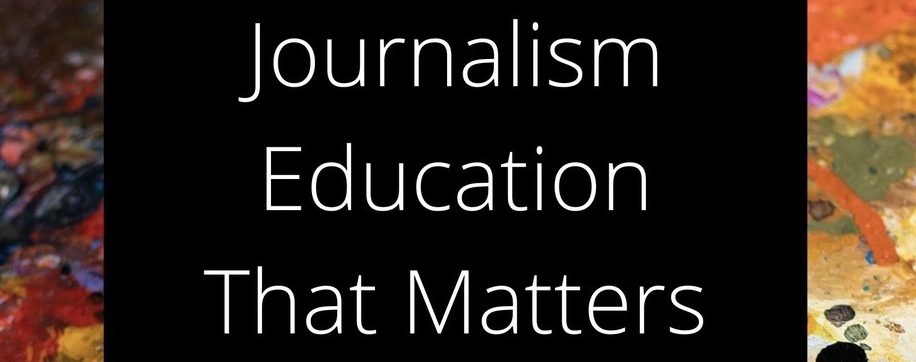In the midst of upheaval, what’s possible to prepare the next generation of journalists?
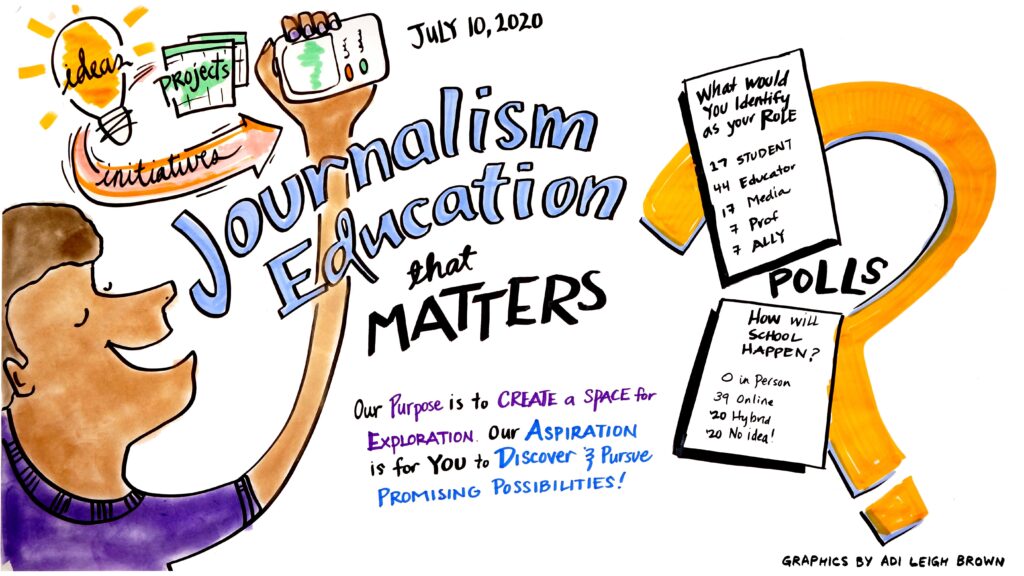
July 10, 1-3pm ET
On Twitter: #JournalismED
Purpose
To create a space for students, educators, media professionals and their allies to discover and pursue promising possibilities.
Agenda
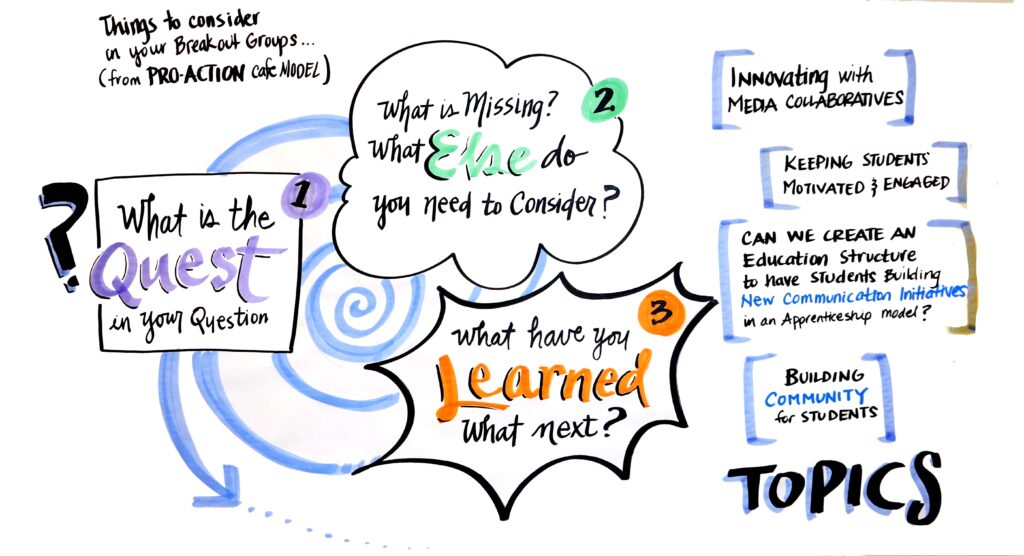
NEED HELP?
Go to the main room. Ben Roberts and Max Resnik are there for you. Already in the main room? Chat to everyone with @HELP if it’s not a “private” question so both Max and Ben see it. Or use chat to send HELP-Max a message privately.
Contact Information. Add your name at the link if you want to share your contact information with others who add their name to this list. [Moved to separate document.]
Check-in
Your poll responses
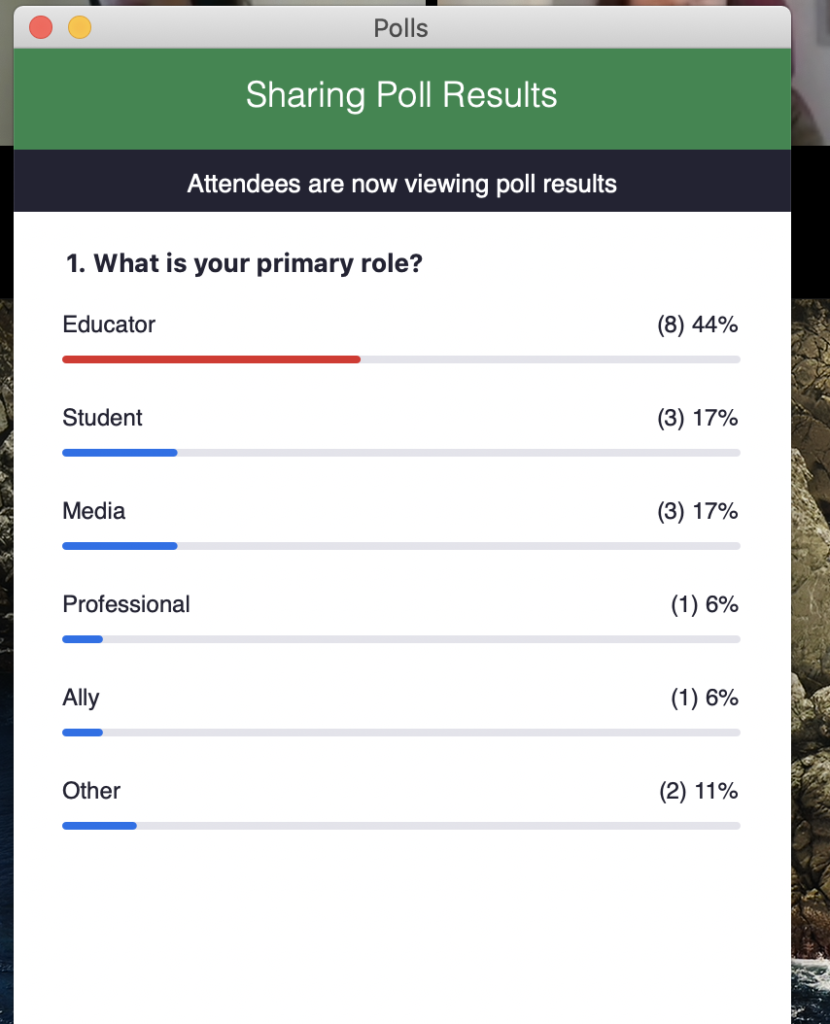

In a word or phrase, what would a healthy fall term look like for you?
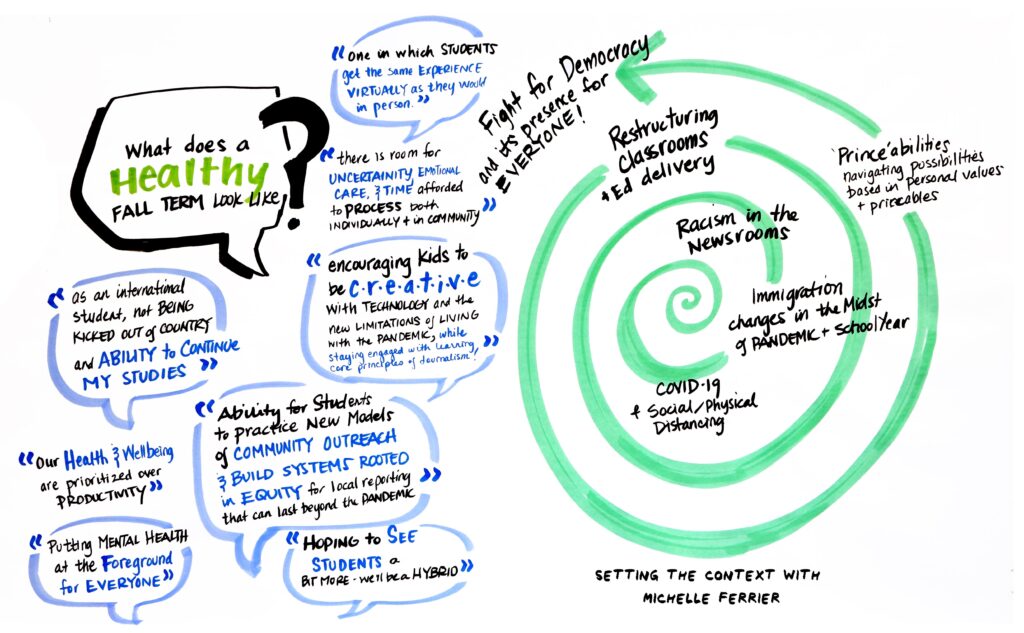
RESPONSE / NAME / LOCATION
| A healthy fall term to me looks like one where students are able to practice new models of community outreach and build systems rooted in equity for local reporting that can last beyond the pandemic / Max / Brooklyn+1 from Alisha Savson |
| Make a decent living as a journalist/writer. / Nick Ng / San Diego, CA |
| Encouraging kids to be creative with technology and the new limitations of living with the pandemic, while also staying engaged with the core principles of journalism, which they are still learning! / Rachel / NY |
| Practicing social justice journalism at a safe social distance/ Rachele/ San Francisco State University |
| Open-ended expectations and support for navigating ambiguity, uncertainty, and likely complicated grief / Megan / Anchorage, AK |
| Prepared and ready to implement empathy. |
| One in which students get the same experience “virtually” as they would in person. |
| Good physical health for students, faculty and staff, along with healthy (robust, effective, etc) learning in class, however that’s articulated — FTF, hybrid, or wholly online — Jack Rosenberry, St. John Fisher, Rochester NY |
| Hoping to SEE students a bit more – we’ll be hybrid. Also hoping my newspaper staff of The Falcon are charged up to have great journalism happen. Also for caution to be great but fear to be suppressed – Peg Achterman, Seattle (Seattle Pacific University) |
| There is room for uncertainty, emotional care, and time afforded to process both individually and in community. Our health and wellbeing are prioritized over productivity. / Sarah / Anchorage, AK |
| That we are safe and can design an immersive curriculum and process that can jumpstart deep community knowledge, listening and action for healing the nation. Michele Ferrier, Media Innovation Collaboratory |
| We are employing newly developed, pandemic-appropriate ways to engage and interact safely and meaningfully with our communities, Laura / Cleveland, OH |
| I’m thinking a lot about mental health — putting that at the foreground for everyone. It’s all about feeling safe. I hope that modeling concern and care for students will not only help them personally, but will help them better interact with their communities, the ones they cover and the ones they are a part of. (And both!) Lori/University of Oregon |
| +1 to: I’m thinking a lot about mental health — putting that at the foreground for everyone. Alisha Savson |
| I’m hoping students feel comfortable with course delivery (whatever form it takes), engaged with learning, and above all, safe. Marina/South Dakota State University |
| All on campus stay as healthy as possible, and together, we explore new ways to learn and practice journalism. John-Erik K. – Bloomsburg University of PA |

From the Zoom chat:
10:26:50 From Peg Achterman : @Michelle – could you post more about the UK person Claire? – with text training? Thanks would love to loo that up
10:27:27 From Org team – Lori Shontz : Claire Wardle is with First Draft, Peg. She just announced a “text” training on disinformation and misinformation.
10:28:05 From Org team – Lori Shontz : SMS course to prepare for US election information: https://firstdraftnews.org/latest/course-training-us-election-misinformation
10:57:30 From HELP – Max Resnik : https://www.niemanlab.org/2020/07/giving-thanks-isnt-just-for-turkey-day-its-also-a-way-to-retain-your-users/
The Sessions
| Rm | SessionHost | Topic/Question (Headline + Description) |
|---|---|---|
| 1 | Karen Magnuson | Innovating with Media Collaboratives How do we leverage the growing number of media collaboratives to help journalists of the future through more effective partnerships with journalism educators? |
| 2 | Rachele Kanigel | Keeping Students Motivated/Engaged How do we keep ALL students motivated and engaged through online or hybrid education despite technological, mental health/mood and practical challenges? |
| 3 | Michelle Ferrier | Can we create an education structure to have students building new communication initiatives in an apprenticeship model rather than bachelor’s degree model? Just-in-time education and coaching directly to a cohort of students distributed geographically? Building in 1:1. |
| 7 | [Joined Room 2] |
Closing Reflections
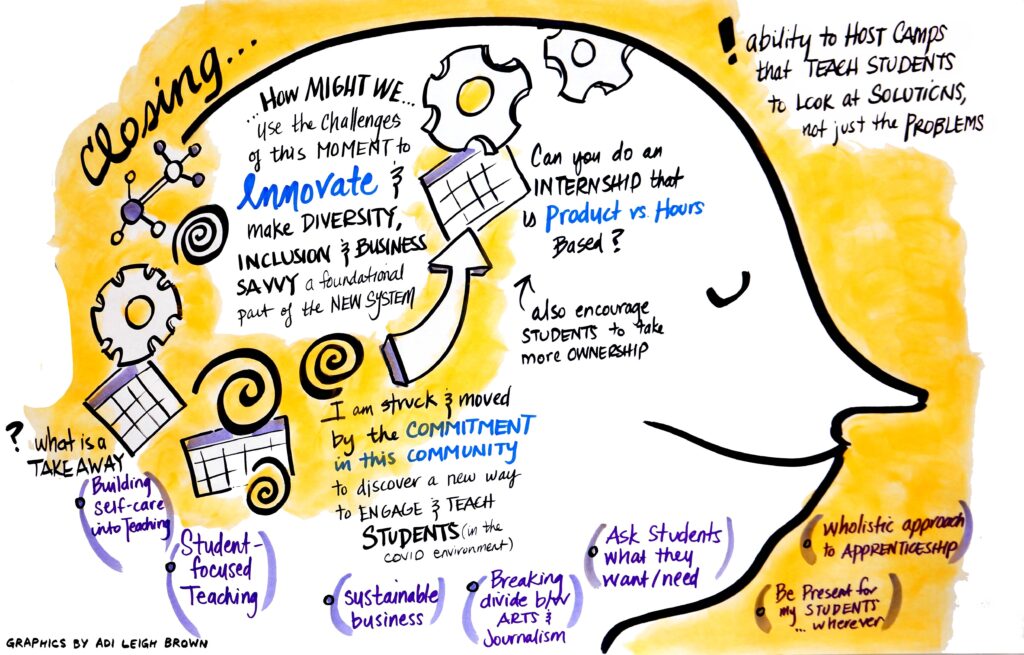
From the Zoom chat:
11:41:28 From 2-Faith Sidlow : Thanks, everyone in group 2!
11:41:39 From 3 – Nick Ng : That 40 minutes went by too fast.
11:41:54 From 2 – John Pettus : Thanks Group 2. Great discussion. Tough problem, but very worthy of working on.
11:41:58 From 1 – Karen Magnuson : My hat goes off to the folks in Group #1. You rock!
11:42:17 From Marina Hendricks : Group 2, can we keep talking during the semester?
11:42:23 From 2-Rachele Kanigel : Thanks to Group 2. Great discussion!
11:42:42 From 2-Rachele Kanigel : @Marina I’m up for keeping the discussion going.
11:42:58 From Marina Hendricks : @Zee, I really appreciated your perspectives. Thanks for joining us.
11:43:16 From Org Team – Zee Ngema : Of course! It was a great discussion – glad I could join
11:43:22 From 2-Rachele Kanigel : @Zee Yes, thanks for providing the student perspective. Really helped us!
11:43:56 From 2-Faith Sidlow : Yes, Zee, very helpful! Thanks for the input.
11:44:26 From 2 – John-Erik Koslosky : I’ll pile on with the Zee thanks, and all the perspectives from Group 2!
11:45:52 From 3 Alisha Savson : Dreaming big dreams Group 3!! // I’m looking forward to learning from the wisdom of Groups 1 & 2.
11:49:09 From 3 – Nick Ng : YES on sooooo many levels. 😀
11:49:57 From 3 – Nick Ng : The old education model is to graduate and “get a job.”
11:50:28 From 2 – John Pettus : Folks interested in sustainable financial models for journalism, I’d recommend looking at Jay Rosen’s Membership Puzzle Project: https://membershippuzzle.org
11:50:50 From 3 Alisha Savson : Thank you John!
11:50:53 From Ambar Castillo : Thanks John! I’ll def check that out
11:51:34 From 3 – Nick Ng : Thank you, John!!
11:51:57 From 3-Org Team_Michelle Ferrier : +100
11:53:16 From 3 – Nick Ng : “Digital economy” I like that. #RabbitHoles
Check-out
What’s a takeaway you plan to pursue?

From the Zoom chat
11:58:32 From 2-Faith Sidlow : Thank you. This was great!
11:58:36 From 3-Kim Fox : Thx.
11:58:41 From 2 Laura Fillbach : Thank you!
11:58:43 From 2 Rachel Veroff : Thanks everyone
11:58:45 From 1 Sarah Modene : thank you everyone!
11:58:47 From 2 – John Pettus : Thx everyone!
11:58:48 From 2-Rachele Kanigel : Big thanks to the organizers and participants! Great session!
11:58:51 From 1-Peg Achterman : great conversations – thank you
11:58:53 From Marina Hendricks : Appreciate this opportunity to collaborate!
11:58:58 From 3 – Nick Ng : ¡Muchas gracias!! Muito obrigado!
11:59:00 From 2 – John-Erik Koslosky : Thanks all. Great discussions today!
11:59:02 From 1-Joe Guvendiren : everyone’s doing great. keep it up!
11:59:06 From 1 – Karen Magnuson : Thanks to the JETM team for organizing!
11:59:16 From Ambar Castillo : I appreciate GROUP 3 and everyone for those ideas & resources & open energy to create a new communications world!!
11:59:21 From 2 – John Pettus : Take care of yourselves and each other!
11:59:21 From 2 – Jack Rosenberry : Great exchanges all the way around!
Discussion Notes
Room 1
Topic: Innovating with Media Collaboratives
Host: Karen Magnuson
Participants: Peg Achterman, Megan Cacciola, Sarah Richmond, Joe Guvendiren
Discussion
What is the quest in your question? For the sake of what?
What is a media collaborative? Groups comprised of media stakeholders and educational institutions who agree to share information and research, often around a specific topic that has been undercovered or that is particularly challenging to cover effectively and comprehensively. Media collaboratives are becoming increasingly popular around the country.
In Alaska, there is a simultaneous tradition of community based journalism (through rural community radio stations, etc) and a distrust of community engaged journalism.
We need to shift the narrative in working with collaboratives, to create a more supportive network for journalists of the future.
What is missing – what else do you need to consider?
There is a lack of consistency — in some areas there are strong partnerships, with other collaboratives there is little to no tangible partnerships with journalism educators and their students. A stronger media ecosystem needs to include students and educators.
Innovative ideas — The partnerships that do exist are fairly predictable in the way partnerships are formed: internships, etc. For collaboratives to be truly successful, they need to be exploring new, innovative ways to collaborate.
Economic stability for students – Most journalism students are already holding down at least one job. Realistically they won’t be able to be a part of collaboratives if they’re not being justly compensated for their time.
Presence and Relationship Building on Campuses — Members of media groups can spend time on campus presenting their ideas and building relationships with both faculty and students.
What am I learning? What now?
Pursue funding so that student journalists can be compensated for being involved.
Innovation = risk. What are people giving up by doing the things that they’re doing? What are you asking students to sacrifice by being a part of media collaboratives. How can we ensure that students will experience some sort of payoff for being involved? $ is a reward, but so are other things: food, access, connections, housing, opportunities.
What would be worth it to you to take this risk?
Can we revisit “internship” vs. “apprenticeship” : the idea of learning based on experience in a field. Be careful: lack of consideration or acknowledgement to amount of time that students are spending outside of all that. Deliverable model vs hourly model. Attach apprenticeships to outcomes where they can innovate along the way. This puts more accountability in the hands of the student to ensure the outcomes are good.
Meet students where they’re at and figure out what more they need to achieve.
Placement Exchange Model.
Summer multimedia academy to give students hope for the possibilities within the journalism field. ← There are some significant barriers to access to this model though.
“Cradle to Career”: invite younger students to become engaged with journalism
Another barrier to our current moment: we can’t physically visit newsrooms right now. It’s likely newsrooms will look very very different in the future.
Where else are these conversations happening?
- Freedom Forum – Jill Geisler
- NPR, Doug Mitchell – Next Gen Radio
- Solutions Journalism Network
- College Media Advisors (CMA)
Room 2
Topic: Keeping Students Motivated/Engaged
Host: Rachele Kanigel
Participants:
- Marina Hendricks
- Lori Shontz
- John-Erik Koslosky
- Jack Rosenberry
- Laura Fillbach
- John Pettus
- Zee Ngema
- Faith Sidlow
- Rachel Verdoff
Participants agree that they are worried that students dropped off spring term as remote learning went on.
Zee on the student perspective:
— More communication/transparency needed at the beginning, especially in a graduate program.
— Three-hour class in person is completely different from three hours on Zoom.
— one class, lecturer have a handout, email it ahead, general idea, look through it and understand what you’re getting into when in the class.
— also option to record classes. Gives you a way to ask more questions. Access it whenever.
— She thought online classes were a cop-out, easier, until she experienced it.
Marina: The Zoom question: what to do. Some students aren’t interested.
Lori: psychological part of having no agency to be online. Agreement that it got worse as the term went on.
Three people, Lori (Penn State), Marina (Kent State), John-Erik (Nebraska-Lincoln, transferred to Chatham), did graduate work online.
Survey students at the beginning and then throughout the semester
Faculty should lay out expectations at the beginning
Consider focusing on news other than COVID-19; otherwise it’s all COVID all the time
Discussion
What is the quest in your question? For the sake of what?
John: Two kinds of engagement: with the material, hard to create with mental health, too many people in house, etc, needed to create learning outcomes. But as second piece: letting students have chit-chat time, create socialization like they would in the hallways. How are these linked? Faith: Students showed up early to talk.
John: How do students engage with each other outside of the classroom when we’re remote?
Rachele: hated discussion forums in my own program. How do we make them engaging?
Jack: many students see as busywork
Group agreement: The exhaustion of online teaching. How do we support each other for that?
From chat:
Jack Rosenberry: I scaled back expectations in a couple of ways. I ditched about one assignment per class. As another example, I let my multimedia journalism students do personal stories — travelogue videos were popular — in place of all hard news. I think that helped address the something fun factor Zee mentioned.
Marina Hendricks : One of my colleagues leads “A Day in the Life” project every spring. He was able to redesign it so students were doing multimedia reporting from wherever they were. Worked really well: https://dayinthelifeofsd.com/
Faith Sidlow : Here is a PP for the 10-2 strategy: Strategies for Active Video Lectures
Room 3
Topic: Apprenticeship Model
Host: Michelle Ferrier
Ambar – summer internship with StoryCorps
- Learning tips & tricks working with Pro Tools
- Learning the actual collaborative process (feels more collaborative within school)
Nick Ng – graduate student & running his own online magazine since 2015
- trying to create jobs with his business right now
- Working with clinicians who want to communicate good information
Kim Fox – journalism professor in Egypt
Alisha Savson
Discussion
What is the quest in your question? For the sake of what?
“I want students to be building it as they’re learning how to fly.”
MF: Thinking about apprenticeship model .
- Works alongside a journalist, OR
- Spoke-and-hub model; like Patch
- Goal: To help build skills as a journalist
- Start when you walk in the door: “What do you know about your community?”
- Develop their product each week.
- By end of apprenticeship, “have a viable business at the end of the end of their practice where they’re practicing journalism”
Nick: Never learned about the business side of doing journalism.
Is there a sustainable career path forward in journalism?
- Kim: Young people may burn out, or they can’t get to a big city to get into the industry. //
- Another potential model: EX: There’s a need for people to help someone figure But there can be a way to connect students
- MF: ISSUE: With higher ed internships that aren’t flexible – what we think is valuable in internships from an educator’s perspective needs to be updated.
- Idea from Ohio: Internship accelerator – help a communications team develop a business.
- MF: Students don’t understand all the options that are around the journalism industry & communications. What about product? Etc.
If we were to design a 12-month program:
- Writing, technology, building relationships, etc. – to launching at the end of that period. What would that include?
What is missing – what else do you need to consider?
Ambar – Missing a diversity element – “Not just one seminar or one workshop” – incorporate this into the curriculum. A lot of POC experience microaggressions and this has a huge impact on whether they stay in journalism. SHould be a major component that’s focused on: navigating getting pushback from white/male perspectives – how to navigate while thinking about your jobs. White folks & POC thinking about this on a regular basis so we “really are training allies and self-advocates.”
- MF: Instead of one diversity meeting a month, this should be infused throughout. We should be training through an intersectional lens. Every journalist should understand how they present in their context and U.S. context – and how this affects their reporting. Need the 360 view.
- Ambar: In interpersonal sense, on content side, on business side. Have those difficult conversations. None of that ‘we have a shared goal here, we’re all here with good intentions!’
Ambar – find points of intersections and collaborations across fields – interdisciplinary. Performance + spoken word + rap and how to merge with visual documentary! Break the dichotomy of arts vs. journalism. With design thinking!
- MF: http://jasirix.com (Spoken word & journalism.)(“Create or Die” hackathons for different ways to news and information.)
AS: Getting a 360-degree view & how all diff forms of journalism can connect together
How to figure out your blind spots, what to call yourself, what to focus on in journalism
MF: Using any means necessary to get the word out to the community, to describe how i’m feeling as a mother, wife, journalist, etc., and it has manifested into my painting
Importance of breaking down Journalism, which traditionally hasn’t served a lot of communities, looking at other ways of doing our work–could be both traditional and arts-based, e.g., news potluck, and coffee/news of the day. Thinking outside the box of traditional journalism. Giving opportunities for diff ppl in diff ways
MF: We don’t need to learn journalism through a four-year-degree. Thinking about breaking the structures all over the place. That’s what I’m trying to do with the media collaborative.
MF: Struggling because – what can we do to help students who are graduating this past spring, this summer? They’ve been training for opportunities that have narrowed even further?
AS: How to be my own LLC & build something that addresses media, info & storytelling gaps
KF: What’s that first step, what can you & your profs & admin can do to help you get there before you have to do it OYO? I’m an educator & there w/ you the whole path–always going to be there to offer some advice. How can you identify & speak to profs about how they can help you get there, whatever that is? We as profs/admin need to do a better job of letting students know what we can offer them, e.g., hosting a coffee talk to discuss potential of apprenticeship-like program
MF: Teaching s’s how to navigate business ventures & the value of your intellectual property & how to protect it. Help broaden the skills of students that they can use in the industry, but also give them a chance to practice
What am I learning? What now?
KF: How to give chances to connect & skills and knowledge to springboard to doing your own thing.
MF: Moving in the direction of a degree program becoming more a la carte. Subverting rules in order to fight legislation, disrupting how education has been packaged & sold to students & parents. How can we bring in those resources from other places? Experts in the lab developing coaching content. Individualized ed model.
KF: Freelancing–trying to get s’s to be thinking like entrepreneurs, to MF and AS’s points. There must be someone in your circle who can help you. In this environment, if you can’t get an internship, even in virtual, or a physical job in media, you have to create your own thing
MF: Thinking outside the box. Looking at credentials into how ppl can demonstrate what skills they have. Blowing up the model & helping ppl to understand that this is a diff environment, so ppl need a diff set of skills
MF: Freelance, how to do engagement not face-to-face, biz skills, how to set up an LLC
KF: more trades school-esque, or…?
MF: W/ a new model & new curriculum, I think an LLC would be a part of that convo
KF: There are a lot of journalists who don’t come from that field but their diff fields make them good journalists. You need that balance, of liberal arts curriculum & also technical
AS: Was a sociology & psychology major in undergrad; that would’ve been a perfect way to incorporate multimedia skills
AC: Like Alan Alda’s work teaching scientists & practitioners how to be better communicators NN: People who know content & technical jargon, teaching how to better express for general audience
MF: 2 models: 1, coaching other educators who had done research or had expertise in particular area helped support educators–I can similar model in this kind of apprenticeship–fishbowl w/ s’s on the inside, talking about what’s going on w/ them in their projects & prob-solving & how to move forward
KF: NN’s idea of doing SEO writing w/o compromising values of JO
(From Chat: One thing I had learned in journalism back in early 2014 when I was freelancing is how to write for SEO without compromising the core values of journalism. This is not taught in my current curriculum and it’s something I’m still learning today. Not sure how this could be applied to mainstream journalism, but in science and health reporting, it’s quite useful. )
NN: Law reporting & other content-specific area: q’s ppl ask will be the same–how do we incorporate into journalism?
MF: Frustrating in the past 20 years – how the heck does the internet work? How is information distributed? Missing in the media curriculum. // We need skill sets from these other areas to figure out
AS: After undergrad, ‘Journalists becoming the everything’ as a concept became the hot thing–not just doing Jo, but also social media posts & emojis &…Something to help you narrow it down to, e.g., ‘My focus is really audio & engagement’
MF: My expression of the same topic is so different from that of others. We haven’t done a good job of teaching s’s how to figure out your specific form of expression & audience & how you’ll tell the story, based on info ecosystem before narrowing down your area / medium
Thanks for taking notes. Kim shared this resource after the session based on comments from AS; This graduate internship model could be applied to other disciplines.
Room 7 – We’ve moved to room 2
Topic: Building community for students Description: How do we keep track of students who might have always showed up to your in-person club, but now seem to have slipped through the cracks with the transition to online learning? How do we keep kids proactive?
Host: Rachel Veroff

